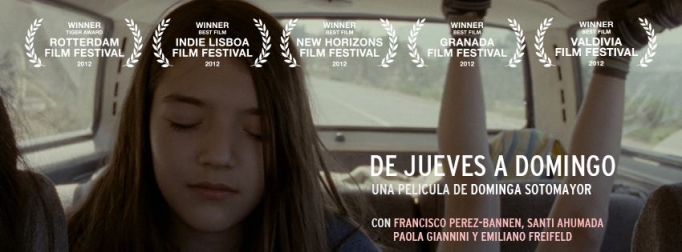The narrative is stripped back to the geological essentials, the film is as contained within the confines of the family car, the occasional leg-stretches through deserts and streams, but also rooted within the little tin space. There is little dialogue, and the dialogue that is present has the same sparsity as the Chilean landscape, it is barren and without the safety of a resolution, we as the audience are left to interpret the real reasons behind the holiday, and like the curious scrutiny of Lucia, we grab at the scraps of information as they are sporadically offered. Perhaps this lack of communication, this kind of withholding by the film, is reflective of the problems in the parent’s marriage. They communicate primarily with looks, shrugs, snubs, but very rarely words. Certainly, the very journey itself feels like it’s filmed with a chronological minuteness, with the mantra of naturalism strictly observed and the muted confinement in the car creating a vacuum of suspended activity. This is flared up ever further through the denial of a soundtrack, no big emotional plot arcs, and the final refusal to completely explain the divergent roads Ana and Fernando are taking.
It is completely unsurprising, and a testament to Sotomayor, that the children, Lucia and Manuel, were not given scripts, but rather were reacting to the situations the adult actors were creating. It is this raw energy, the irrepressibly uncertainty, of Lucia that really haunts the film; she is silently crying out for her parents to facilitate the safety of the next line, of the future. It is the uncertainty of the family dynamic changing during a divorce that often causes the most pain, the fear that happiness and security is now a thing that has driven past and can only be seen in the distance, obscured by a cloud of dust. Indeed, as viewers we are thrust into Lucia’s perspective of anxious uncertainty, seeing the narrative slowly evolving, the little snatches of comprehension and truth we can discern feeling like semi-precious stones glinting through the dusty silence of the Chilean landscape. The camerawork too reflects this stasis, with long, static shots in which the action almost seems incidental, the camera being so reactionless (or perhaps contemplative). We become so accustomed to this steady gaze that we really feel the movement the few times it does become handheld and uprooted.
What really succeeds in this is its apparent scarceness, in that it forces us as an audience to really look at the disintegration of a marriage, to have the blank, silent glances thrown by Lucia reverberate through the frame, all the while being aware of the process of emotional bartering and burying being undertaken by Ana and Fernando, who are trying to negotiate their way through their barren relationship, looking for the right turning, and hoping their car holds out.
Words: Ryan McNab


